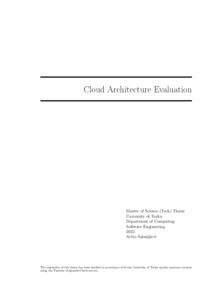Cloud Architecture Evaluation
Salmijärvi, Arttu (2023-05-03)
Cloud Architecture Evaluation
Salmijärvi, Arttu
(03.05.2023)
Julkaisu on tekijänoikeussäännösten alainen. Teosta voi lukea ja tulostaa henkilökohtaista käyttöä varten. Käyttö kaupallisiin tarkoituksiin on kielletty.
avoin
Julkaisun pysyvä osoite on:
https://urn.fi/URN:NBN:fi-fe2023052346739
https://urn.fi/URN:NBN:fi-fe2023052346739
Tiivistelmä
Cloud computing has introduced numerous ways to build software systems in the cloud environment. The complexity of today’s system architectures require architecture evaluation in the designing phase of the system, in the implementation phase, and in the maintenance phase. There are many different architecture evaluation models. This thesis discusses three different evaluation models: architecture tradeoff analysis method, cost-benefit analysis method, and AWS Well-Architected framework. The AWS Well-Architected framework is deeply evaluated by performing an architectural evaluation for the case study software: Lixani 5. This thesis introduces and compares the opportunities for cloud architecture evaluation by literature review, case study, and interviews with experts.
The thesis begins with introduction to cloud computing, cloud architecture models and architecture evaluation methods. An architecture evaluation for a case study software is then carried out. This thesis also contains interviews with experts, producing knowledge on how the system architecture is being evaluated in the field. The research methods used in the thesis are literature review, case study, and expert interviews. This thesis attempts to describe and assess the architecture evaluation models by using the research methods. In addition, this thesis introduces and discusses the case study software – Lixani 5 – and its architectural decisions.
Based on research in the thesis it was noted that all three studied software architecture evaluation models are suitable options for reviewing software architecture. All models included positive and negative aspects and none of them was seen as superior compared to the others. Based on the interviews with experts it was noted that there are also multiple other efficient ways to evaluate the system architecture than the models discussed in the thesis. These ways included a technology audit template and a proof-of-concept culture.
The thesis begins with introduction to cloud computing, cloud architecture models and architecture evaluation methods. An architecture evaluation for a case study software is then carried out. This thesis also contains interviews with experts, producing knowledge on how the system architecture is being evaluated in the field. The research methods used in the thesis are literature review, case study, and expert interviews. This thesis attempts to describe and assess the architecture evaluation models by using the research methods. In addition, this thesis introduces and discusses the case study software – Lixani 5 – and its architectural decisions.
Based on research in the thesis it was noted that all three studied software architecture evaluation models are suitable options for reviewing software architecture. All models included positive and negative aspects and none of them was seen as superior compared to the others. Based on the interviews with experts it was noted that there are also multiple other efficient ways to evaluate the system architecture than the models discussed in the thesis. These ways included a technology audit template and a proof-of-concept culture.
